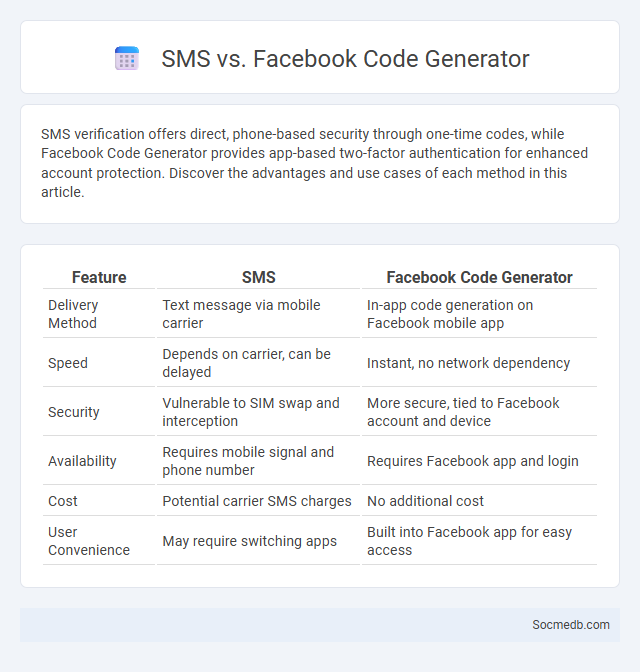
Photo illustration: SMS vs Facebook Code Generator
SMS verification offers direct, phone-based security through one-time codes, while Facebook Code Generator provides app-based two-factor authentication for enhanced account protection. Discover the advantages and use cases of each method in this article.
Table of Comparison
| Feature | SMS | Facebook Code Generator |
|---|---|---|
| Delivery Method | Text message via mobile carrier | In-app code generation on Facebook mobile app |
| Speed | Depends on carrier, can be delayed | Instant, no network dependency |
| Security | Vulnerable to SIM swap and interception | More secure, tied to Facebook account and device |
| Availability | Requires mobile signal and phone number | Requires Facebook app and login |
| Cost | Potential carrier SMS charges | No additional cost |
| User Convenience | May require switching apps | Built into Facebook app for easy access |
Introduction to Authentication Methods
Authentication methods on social media are critical for safeguarding your account from unauthorized access and identity theft. Techniques such as two-factor authentication (2FA), biometric verification, and single sign-on (SSO) enhance security by requiring multiple forms of identity confirmation before granting access. Selecting robust authentication methods tailored to your platform can significantly reduce the risk of cyber threats and protect your personal information.
What is SMS Authentication?
SMS authentication is a security process that verifies a user's identity by sending a unique code via text message to their registered mobile phone number. This two-factor authentication method enhances account protection by requiring both a password and a one-time SMS code. Widely used across social media platforms, SMS authentication helps prevent unauthorized access and safeguards personal information.
Overview of Facebook Code Generator
Facebook Code Generator is a security feature integrated within the Facebook app to enhance account protection through two-factor authentication (2FA). It generates time-sensitive codes on a user's mobile device, eliminating the need for SMS-based verification and reducing the risk of unauthorized access. This tool supports seamless login verification for Facebook accounts, ensuring improved security alongside traditional password measures.
Understanding Two-Factor Authentication (2FA)
Two-Factor Authentication (2FA) strengthens your social media security by requiring two forms of verification, typically something you know (password) and something you have (a code sent to your phone). This additional layer significantly reduces the risk of unauthorized access, even if your password is compromised. Enabling 2FA on platforms like Facebook, Instagram, and Twitter ensures your accounts remain more secure against hacking attempts.
Security Comparison: SMS vs Code Generator vs 2FA
When choosing between SMS, code generators, and two-factor authentication (2FA) apps for securing your accounts, understanding their effectiveness is crucial. SMS verification is vulnerable to SIM swapping and interception, making it the least secure option. Code generators and dedicated 2FA apps, which produce time-based one-time passwords (TOTP), provide stronger protection by generating unique codes offline, significantly enhancing your account security against phishing and unauthorized access.
Usability and User Experience
Social media platforms prioritize usability by offering intuitive navigation, streamlined interfaces, and customizable features that enhance user engagement. User experience is optimized through responsive design, fast load times, and personalized content algorithms that cater to individual preferences. Continuous user feedback integration drives improvements in accessibility and functionality, ensuring seamless interaction across devices.
Vulnerabilities and Risks
Social media platforms expose Your personal information to vulnerabilities such as data breaches, phishing scams, and identity theft, putting Your privacy at significant risk. Cybercriminals exploit weak security settings and social engineering tactics to gain unauthorized access to accounts, leading to potential financial loss and reputational damage. Understanding these risks and implementing strong security measures is crucial to protect Your digital footprint effectively.
Integration with Popular Platforms
Seamless integration with popular social media platforms like Facebook, Instagram, Twitter, and LinkedIn enhances user engagement by enabling direct content sharing, unified messaging, and real-time analytics. APIs provided by these platforms support automated posting, audience targeting, and cross-platform campaign management, increasing marketing efficiency and reach. Leveraging tools like Facebook Pixel and Twitter Cards further optimizes ad performance and user interaction tracking across multiple channels.
Best Practices for Account Protection
Protect your social media accounts by enabling two-factor authentication (2FA) to add an extra layer of security beyond just passwords. Use strong, unique passwords for each platform and update them regularly to reduce the risk of unauthorized access. Monitor account activity closely and be cautious about sharing personal information to safeguard Your online presence effectively.
Choosing the Right Authentication Method for You
Choosing the right social media authentication method enhances account security by balancing convenience and protection. Biometric verification, such as fingerprint or facial recognition, offers fast and secure access, while two-factor authentication (2FA) adds an extra layer by requiring a secondary code from a trusted device. Implementing a method aligned with personal security needs and device compatibility helps safeguard digital identity against unauthorized access.
 socmedb.com
socmedb.com